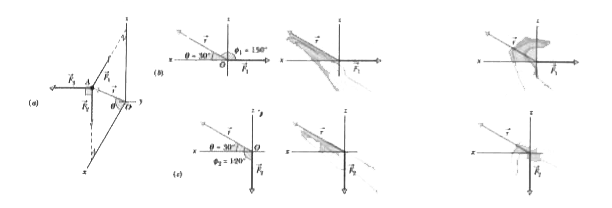In Fig., three forces, each of magnitude 2.0 N, act on a particle. The particle is in the xz' plane at point A given by position vector →r, where r = 3.0 m and θ=30∘. What is the torque, about the origin O, due to each force?
Text Solution
Because the three force vectors do not lie in a plane, we must use cross products, with magnitudes given by Eq. (τ=rFsinϕ) and direction given by the right-hand rule.
Calculations: Because we want the torque with respect to the origin O, the vector →r required for each cross product is the given position vector. To determine the angle ϕ between →r and each force, we shift the force vectors of Fig. each in turn, so that their tails are at the origin. Fig., c, and d, which are direct views of the xz plane, show the shifted force vectors →F1,→F2and→F3,


respectively. In the angle between the direction of →r and →F3 is 90∘ and the symbol means →F3 is directed into the page.
τ1=rF1sinϕ1=(3.0m)(2.0N)(sin150∘)=3.0N⋅m,
τ2=rF2sinϕ2=(3.0m)(2.0N)(sin120∘)=5.2N⋅m
and τ3=rF3sinϕ3=(3.0m)(2.0N)(sin90∘)=6.0N⋅m.
|
Topper's Solved these Questions
- RIGID BODY DYNAMICS - IBOOK - RESNICK AND HALLIDAYCHAPTER - RIGID BODY DYNAMICS - IEXERCISE - CHECKPOINT
18 Videos
- RIGID BODY DYNAMICS - IBOOK - RESNICK AND HALLIDAYCHAPTER - RIGID BODY DYNAMICS - IEXERCISE - PROBLEMS
100 Videos
- RELATIVITYBOOK - RESNICK AND HALLIDAYCHAPTER - RELATIVITYEXERCISE - PRACTICE QUESTIONS (Integer Type)
5 Videos
- RIGID BODY DYNAMICS-IIBOOK - RESNICK AND HALLIDAYCHAPTER - RIGID BODY DYNAMICS-IIEXERCISE - PRACTICE QUESTIONS (Integer Type)
2 Videos
Similar Questions
Knowledge Check
The force 7ˆi+3ˆj−5ˆk acts on a particle whose position vector is ˆi−ˆj+ˆk . What is the torque of a given force about the origin ?
A2ˆi+12ˆj+10ˆkB2ˆi+10ˆj+12ˆkC2ˆi+10ˆj+10ˆkD10ˆi+2ˆj+ˆkIf →F is the force acting in a particle having position vector →r and →τ be the torque of this force about the origin, then
A→r.→τ≠0and→F.→τ=0B→r.→τ>0and→F.→τ<0C→r.→τ=0and→F.→τ=0D→r.→τ=0and→F.→τ≠0Let →F be the force acting on a particle having position vector →r and →τ be the torque of this force about the origin. Then
A→r.→τ≠0and→F.→τ≠0B→r.→τ=≠0and→F.→τ=0C→r.→τ=≠0and→F.→τ≠0D→r.→τ=0and→F.→τ=0
If →F is the force acting in a particle having position vector →r and →τ be the torque of this force about the origin, then
View SolutionThe force 7ˆi+3ˆj−5ˆk acts on a particle whose position vector is ˆi−ˆj+ˆk. What is the torque of a given force about the origin ?
View SolutionLet →F be the force acitng on a paritcle having positon vector →rand→T be the torque of this force about the origin. Then
View SolutionLet →F be the force acitng on a paritcle having positon vector →rand→T be the torque of this force about the origin. Then
View SolutionLet →F be a force acting on a particle having positon vector →r.Let→τ be the torque of this force about the origin then
View Solution
